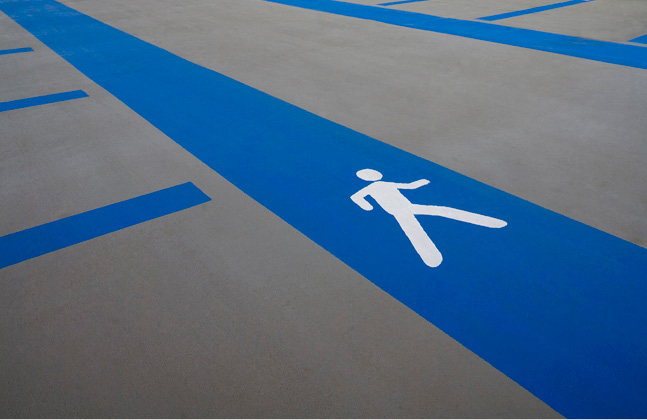January is a time when many countries around the world can expect some of the year’s wettest weather.
In Australia for example, intense deluges of heavy rainfall often hit Queensland, with this year being no exception. And in Malaysia the government believes that the torrential flooding since December has caused over USD 200 million worth of damage.
This adverse weather can create a long list of problems for large-scale facilities, especially for sizeable, bare concrete structures such as exposed multi-storey car parks, warehouses and industrial sites. Not only could water ingress weaken the structural integrity of a building, but large bodies of water can also create serious health and safety risks.
We’ve compiled the following advice to help facilities managers learn about the problems caused by flooding and how correctly specified resin floor coatings can help them to refurbish and provide protection against rainfall in the future.
Corrosive ContaminantsIf large amounts of water get into the joints and cracks of bare concrete then it can lead to lime and corrosive contaminants being flushed out of the concrete. In car parks these contaminants could fall onto vehicles and damage the paintwork, which could lead to expensive legal and insurance costs.
To create a safe and secure environment that reduces these hazards, a robust and waterproof deck coating should be installed to prevent the water from getting into the vulnerable concrete.
Salt + Water = Concrete Spalling
Locations with high levels of salt in the atmosphere need to be aware that salt and water can be a highly damaging combination. Commercial concrete slabs feature steel reinforcements, which will rust if they come into contact with salt and water. This can cause the steel to expand up to five times its previous size, which in turn will lead to concrete spalling (look out for concrete staining, this is the first sign of concrete spalling, followed by the disintegration of the concrete itself).
Once this has happened the integrity of the structure is compromised and patches of concrete could fall away, which is not only a risk to both people and property but can lead to negligence claims being made against the building’s owner or operator.
In these environments it is especially important to safeguard the site against concrete spalling by installing floor and wall coatings that are able to form an impermeable barrier against large volumes of salt and water.
Slip and Trip Hazards
Anyone entering a site that has just experienced flooding will inevitably be faced with a long list of slip hazards, from ponding water, debris and deteriorating concrete to name just a few.
By acting before the flood occurs, buildings in locations prone to flooding can ensure that their floors are ready to minimise and overcome these dangers. Key criteria that will prove invaluable in a flood are having floors with the correct drainage gradients as well as a textured finish that enhances grip underfoot.
The pattern and design on the floor can also be used in this instance, as easy-to-see, colourful demarcation can help people safely navigate around the site – an attribute that will also be useful during day-to-day work.
Car Park Tyre Squeal
When water gets into a car park’s interior it can cause another, potentially unforeseen, consequence – loud tyre squealing. This occurs as the wet floor reduces friction and exacerbates the squeaks and screeches made when a vehicle turns on a burnished or poorly sealed concrete floor.
To minimise noise levels during the wet season deck coating systems with anti-slip aggregates should be installed, as these additives create extra friction between the floor and the tyre which helps to remove the root cause of tyre squeals (hint – make doubly sure to incorporate anti-slip aggregates into areas of the car park with tight turning circles).
Industrial Refurbishment
Many industrial sites in the eight Malaysian states affected by flooding are now turning to the task of refurbishing. These rebuilding works could come at quite a cost, as the Federal Minister suggested that the government’s infrastructure losses alone could be as high as USD560 million.
Resin flooring solutions can be utilised to repair floors damaged by flooding and to also provide waterproof, impermeable surfaces to mitigate flood damage in the future.
Resin systems provide a wealth of options and formulations, including epoxy, polyurethane and methyl methacrylate solutions. Many intensive industrial environments opt for thick, trowel applied epoxy mortars.
Our extensive product range and the customisable nature of the Flowcrete systems allows building operators to specify a solution that not only brings the floor area back up to a serviceable standard but which safeguards and optimises this crucial area of the facility.
Specifying for Flooding
Facility managers and building owners specifying refurbishment solutions have to ensure that the correct materials are chosen and properly installed while factoring in vital safety and hygiene concerns – and all the time managing tight turn-around schedules.
We would recommend that flooring for car parks and industrial facilities in flood risk zones should meet the following key criteria:
- Waterproof
- Crack-Bridging
- Excellent Bond Strength
- Excellent Chemical Resistance
- High Abrasion Resistance
Our experts are available to provide flooring assistance for businesses recovering from the aftermath of a flood, as they can recommend refurbishment solutions that take into account the building’s current condition and the demands that will be placed on it in the future
The owners and managers of industrial and car park environments can get a thorough understanding of the options available to them by talking over the benefits, practicalities and capabilities of flooring products such as Flowcoat, Flowshield, Flowtex, Deckshield and the Flowfresh range of antimicrobial floors.
Click here to talk to a Flowcrete Australia expert and here to talk to a Flowcrete Asia resin flooring specialist.






This must be an knowledgeable article.. Thanks for Sharing it!!!